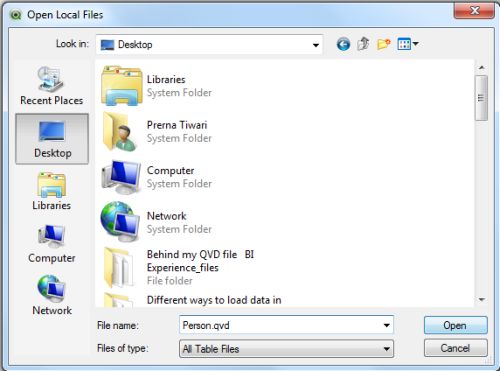How To Open Qvd Files In Qlikview Demo

A QVD file is loaded to a QlikView document in a similar way as other files like CSV, Excel and delimited files are used. We use the the Open option available.
Using QVD files for incremental load Incremental load is a very common task in relation to data bases. It is defined as loading nothing but new or changed records from the database. All other data should already be available, in one way or another. With it is possible to perform incremental load in most cases. The basic process is described below: 1. Load the new data from Database table (a slow process, but loading a limited number of records).
Load the old data from QVD file (loading many records, but a much faster process). Create a new QVD file.
Repeat the procedure for every table loaded. The complexity of the actual solution depends on the nature of the source database, but the following basic cases can be identified: 1) (typically log files 2) 3) 4) Below you will find outlined solutions for each of these cases. The reading of QVD files can be done in either optimized mode or standard mode. (The method employed is automatically selected by the QlikView script engine depending on the complexity of the operation.) Optimized mode is (very approximately) about 10x faster than standard mode or about 100x faster than loading the database in the ordinary fashion. Case 1: Append Only The simplest case is the one of log files; files in which records are only appended and never deleted.
The following conditions apply: • The database must be a log file (or some other file in which records are appended and not inserted or deleted) which is contained in a text file (no ODBC/OLE DB). • QlikView keeps track of the number of records that have been previously read and loads only records added at the end of the file. Example: Buffer (Incremental) Load * From LogFile.txt (ansi, txt, delimiter is ' t', embedded labels); Case 2: Insert Only (No Update or Delete) If the data resides in a database other than a simple log file the case 1 approach will not work. However, the problem can still be solved with minimum amount of extra work. The following conditions apply: • The data source can be any database. • QlikView loads records inserted in the database after the last script execution. • A field ModificationDate (or similar) is required for QlikView to recognize which records are new.
Example: QV_Table: SQL SELECT PrimaryKey, X, Y FROM DB_TABLE WHERE ModificationTime >= #$(LastExecTime)# AND ModificationTime = #$(LastExecTime)#; Concatenate LOAD PrimaryKey, X, Y FROM File.QVD WHERE NOT Exists(PrimaryKey); STORE QV_Table INTO File.QVD; Case 4: Insert, Update and Delete The most difficult case to handle is when records are actually deleted from the source database between script executions. The following conditions apply: • The data source can be any database. Giochi con carte siciliane gratis. • QlikView loads records inserted into the database or updated in the database after the last script execution. • QlikView removes records deleted from the database after the last script execution. • A field ModificationDate (or similar) is required for QlikView to recognize which records are new.